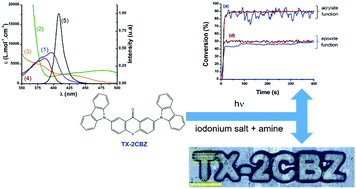Donor–acceptor–donor structured thioxanthone derivatives as visible photoinitiators†
Abstract
Three thioxanthone derivatives differing by their peripheral groups have been investigated as visible light photoinitiators of polymerisation. Their reactivity and efficiency have been compared with that of a commercial type II photoinitiator (2-isopropylthioxanthone – ITX) in the case of free radical polymerisation, cationic polymerisation and interpenetrated polymer networks synthesis for 25 μm or 1.4 mm thick samples under 405 nm LED irradiation. They are incorporated into either, a two-component system with an iodonium salt or an amine, or a three-component system combining an iodonium salt and an amine. Using absorption and fluorescence spectroscopies, laser flash photolysis and molecular modelling, optical properties, excited state energies and lifetimes of these thioxanthone derivatives have been determined allowing a better understanding of the associated chemical mechanisms. Interestingly, the main reaction pathway for one of these thioxanthone derivatives in the photoinitiating systems was determined as involving its singlet state S1 whereas ITX and thioxanthones are known to react from their triplet excited state T1. The high efficiency of the new initiating systems was found as being worthwhile for laser write applications @405 nm but also for high migration stability.



 Please wait while we load your content...
Please wait while we load your content...